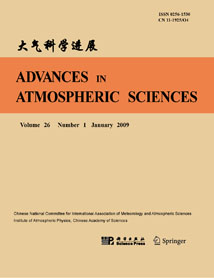| [1] |
Xiaoyan WU, Jinyuan XIN, Wenyu ZHANG, Chongshui GONG, Yining MA, Yongjing MA, Tianxue WEN, Zirui LIU, Shili TIAN, Yuesi WANG, Fangkun WU,
2020: Optical, Radiative and Chemical Characteristics of Aerosol in Changsha City, Central China, ADVANCES IN ATMOSPHERIC SCIENCES, 37, 1310-1322.
doi: 10.1007/s00376-020-0076-9
|
| [2] |
YUE Xu, WANG Huijun, LIAO Hong, FAN Ke,
2010: Direct Climatic Effect of Dust Aerosol in the NCAR Community Atmosphere Model Version 3 (CAM3), ADVANCES IN ATMOSPHERIC SCIENCES, 27, 230-242.
doi: 10.1007/s00376-009-8170-z
|
| [3] |
Boru MAI, Xuejiao DENG, Zhanqing LI, Jianjun LIU, Xiang'ao XIA, Huizheng CHE, Xia LIU, Fei LI, Yu ZOU, Maureen CRIBB,
2018: Aerosol Optical Properties and Radiative Impacts in the Pearl River Delta Region of China during the Dry Season, ADVANCES IN ATMOSPHERIC SCIENCES, 35, 195-208.
doi: 10.1007/s00376-017-7092-4
|
| [4] |
LI Jiandong, Zhian SUN, LIU Yimin, Jiangnan LI, Wei-Chyung WANG, WU Guoxiong,
2012: A Study on Sulfate Optical Properties and Direct Radiative Forcing Using LASG-IAP General Circulation Model, ADVANCES IN ATMOSPHERIC SCIENCES, 29, 1185-1199.
doi: 10.1007/s00376-012-1257-y
|
| [5] |
FAN Xuehua, XIA Xiang'ao, CHEN Hongbin,
2015: Comparison of Column-Integrated Aerosol Optical and Physical Properties in an Urban and Suburban Site on the North China Plain, ADVANCES IN ATMOSPHERIC SCIENCES, 32, 477-486.
doi: 10.1007/s00376-014-4097-0
|
| [6] |
ZHANG Hua, WANG Zhili, GUO Pinwen, WANG Zaizhi,
2009: A Modeling Study of the Effects of Direct Radiative Forcing Due to Carbonaceous Aerosol on the Climate in East Asia, ADVANCES IN ATMOSPHERIC SCIENCES, 26, 57-66.
doi: 10.1007/s00376-009-0057-5
|
| [7] |
Yongjing MA, Jinyuan XIN, Yining MA, Lingbin KONG, Kequan ZHANG, Wenyu ZHANG, Yuesi WANG, Xiuqin WANG, Yongfeng ZHU,
2017: Optical Properties and Source Analysis of Aerosols over a Desert Area in Dunhuang, Northwest China, ADVANCES IN ATMOSPHERIC SCIENCES, 34, 1017-1026.
doi: 10.1007/s00376-016-6224-6
|
| [8] |
SHAO Longyi, LI Weijun, XIAO Zhenghui, SUN Zhenquan,
2008: The Mineralogy and Possible Sources of Spring Dust Particles over Beijing, ADVANCES IN ATMOSPHERIC SCIENCES, 25, 395-403.
doi: 10.1007/s00376-008-0395-8
|
| [9] |
Junlin AN, Huan LV, Min XUE, Zefeng ZHANG, Bo HU, Junxiu WANG, Bin ZHU,
2021: Analysis of the Effect of Optical Properties of Black Carbon on Ozone in an Urban Environment at the Yangtze River Delta, China, ADVANCES IN ATMOSPHERIC SCIENCES, 38, 1153-1164.
doi: 10.1007/s00376-021-0367-9
|
| [10] |
LIU Yuzhi, SHI Guangyu, XIE Yongkun,
2013: Impact of Dust Aerosol on Glacial-Interglacial Climate, ADVANCES IN ATMOSPHERIC SCIENCES, 30, 1725-1731.
doi: 10.1007/s00376-013-2289-7
|
| [11] |
SUN Zhian, WANG Xiaoyun, ZENG Xianning,
2006: Radiative Forcing of SO2 and NOx: A Case Study in Beijing, ADVANCES IN ATMOSPHERIC SCIENCES, 23, 317-322.
doi: 10.1007/s00376-006-0317-6
|
| [12] |
WANG Zhili, ZHANG Hua, SHEN Xueshun,
2011: Radiative Forcing and Climate Response Due to Black Carbon in Snow and Ice, ADVANCES IN ATMOSPHERIC SCIENCES, 28, 1336-1344.
doi: 10.1007/s00376-011-0117-5
|
| [13] |
Hui XU, Jianping GUO, Jian LI, Lin LIU, Tianmeng CHEN, Xiaoran GUO, Yanmin LYU, Ding WANG, Yi HAN, Qi CHEN, Yong ZHANG,
2021: The Significant Role of Radiosonde-measured Cloud-base Height in the Estimation of Cloud Radiative Forcing, ADVANCES IN ATMOSPHERIC SCIENCES, 38, 1552-1565.
doi: 10.1007/s00376-021-0431-5
|
| [14] |
ZHANG Hua, ZHANG Ruoyu, and SHI Guangyu,
2013: An updated estimation of radiative forcing due to CO2 and its effect on global surface temperature change, ADVANCES IN ATMOSPHERIC SCIENCES, 30, 1017-1024.
doi: 10.1007/s00376-012-2204-7
|
| [15] |
Wushao Lin, Lei Bi,
2024: Optical modeling of sea salt aerosols using in situ measured size distributions and the impact of larger size particles, ADVANCES IN ATMOSPHERIC SCIENCES.
doi: 10.1007/s00376-024-3351-3
|
| [16] |
Siyu CHEN, Dan ZHAO, Jianping HUANG, Jiaqi HE, Yu CHEN, Junyan CHEN, Hongru BI, Gaotong LOU, Shikang DU, Yue ZHANG, Fan YANG,
2023: Mongolia Contributed More than 42% of the Dust Concentrations in Northern China in March and April 2023, ADVANCES IN ATMOSPHERIC SCIENCES, 40, 1549-1557.
doi: 10.1007/s00376-023-3062-1
|
| [17] |
Hu Rongming, Serge Planton, Michel Déque, Pascal Marquet, Alain Braun,
2001: Why Is the Climate Forcing of Sulfate Aerosols So Uncertain?, ADVANCES IN ATMOSPHERIC SCIENCES, 18, 1103-1120.
doi: 10.1007/s00376-001-0026-0
|
| [18] |
ZHANG Renjian, FU Congbin, HAN Zhiwei, ZHU Chongshu,
2008: Characteristics of Elemental Composition of PM2.5 in the Spring Period at Tongyu in the Semi-arid Region of Northeast China, ADVANCES IN ATMOSPHERIC SCIENCES, 25, 922-931.
doi: 10.1007/s00376-008-0922-7
|
| [19] |
CHE Huizheng, ZHANG Xiaoye, Stephane ALFRARO, Bernadette CHATENET, Laurent GOMES, ZHAO Jianqi,
2009: Aerosol Optical Properties and Its Radiative Forcing over Yulin, China in 2001 and 2002, ADVANCES IN ATMOSPHERIC SCIENCES, 26, 564-576.
doi: 10.1007/s00376-009-0564-4
|
| [20] |
LIAO Hong, CHANG Wenyuan, YANG Yang,
2015: Climatic Effects of Air Pollutants over China: A Review, ADVANCES IN ATMOSPHERIC SCIENCES, 32, 115-139.
doi: 10.1007/s00376-014-0013-x
|















 AAS Website
AAS Website 
 AAS WeChat
AAS WeChat 
 DownLoad:
DownLoad: